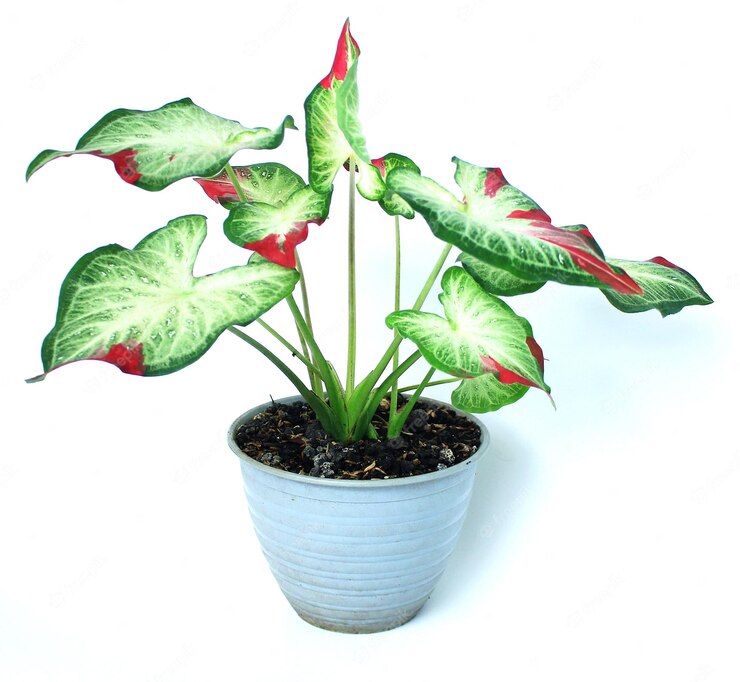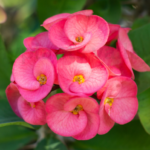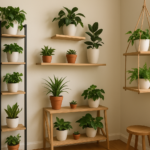Alocasia Quilted Dreams, with its stunning and unique foliage, is a plant that will captivate any indoor plant enthusiast. As with any plant, it needs proper care to thrive. One crucial aspect of caring for this beauty is ensuring the right amount of light. Alocasia Sinuata quilted dreams prefer bright, indirect light, as direct sunlight can scorch its delicate leaves. It is ideal to place it near a window facing east or west. Another essential factor is humidity. This plant loves high humidity, so misting its leaves regularly or placing a humidifier nearby will help recreate its natural tropical habitat. When it comes to watering, it’s essential to strike a balance.
What are Alocasia Quilted Dreams?

Alocasia sinuata, also called Alocasia quilted dreams, is a species of the genus Alocasia. This species was introduced by Nicholas Edward Brown in 1885.
It is native to the Philippines and it grows in the limestone forests of Samar, Leyte, and parts of Mindanao in the Philippines.
This stunning tropical perennial belongs to the Araceae family and showcases an exquisite quilt-like pattern on its leaves.
Each leaf exhibits a striking combination of deep green hues, contrasting veins in varying shades of white or cream, and prominent ridges that enhance the three-dimensional appearance. The enchanting design gives this cultivar an unparalleled visual appeal, making it a captivating addition to any indoor garden or botanical collection.
Specifications
Common Name: Alocasia Quilted Dreams
Botanical Name: Alocasia Polly ‘Quilted Dreams’
Plant Type: Tropical Houseplant
Size: Can grow up to 14 inches (35 cm)
Foliage:
- Leaf Shape: Arrowhead-shaped
- Leaf Color: Dark green with striking silvery-white veins
- Leaf Texture: Textured and quilted appearance
Temperature: Between 60° and 80°F (16° and 27°C)
Humidity: Best above 60%
Cold hardy: Not cold hardy
Propagation: Through seeds, plant division, and offsets
Toxicity: Toxic to humans and animals
How do you care for Alocasia Quilted Dream?
Alocasia ‘Quilted Dreams’ is a stunning and unique plant known for its quilted foliage. You must provide the proper care to keep this plant healthy and thriving. Here’s a comprehensive guide on how to take care of Alocasia ‘Quilted Dreams’:
Light requirements
Light is an essential factor in the growth and development of Alocasia Quilted Dreams. Direct sunlight isn’t necessary for them, but they benefit a little. Place your Alocasia near a window with filtered sunlight, or create shade using sheer curtains. Sunlight can scorch its delicate leaves, so keep it away from direct sunlight.
Soil and potting mix tips
Soil and potting mix are crucial for the health of your Alocasia Quilted Dreams. This plant thrives in well-draining soil to prevent waterlogging, which can lead to root rot. Ensure the potting mix drains well, retains moisture, and doesn’t stay too wet. This will provide essential nutrients and improve moisture retention without causing excess water retention.
Fertilizer Requirement for Alocasia Quilted Dreams
The fertilizer requirement for Alocasia Quilted Dreams is essential for this stunning plant’s proper growth and development. Alocasia quilted dreams vs. dragon scale, known for its striking foliage and unique patterns, requires a balanced fertilizer regime to thrive. When it comes to fertilizing Alocasia Quilted Dreams, it is recommended to use a well-balanced, slow-release fertilizer with a ratio of N-P-K (nitrogen-phosphorus-potassium) explicitly formulated for houseplants.
Feed with a balanced, liquid fertilizer diluted to half strength every 2-4 weeks during the growing season (spring and summer). Reduce or stop fertilizing in the winter when the plant is dormant. Using appropriate fertilizer, Alocasia Quilted Dreams can achieve optimal growth, vibrant foliage, and overall health.
Watering schedule and techniques
The watering schedule and techniques of Alocasia Quilted Dreams are crucial for the successful growth and maintenance of this unique plant. Quilted dreams alocasia requires regular watering to keep the soil consistently moist but not soggy. To ensure optimal growth, one should check the top inch of soil for dryness before watering again. It is beneficial to use room temperature or lukewarm water as cold water can shock the sensitive roots of this plant species. Maintaining a consistent watering routine while paying attention to signs of under and over-watering will help promote healthy growth for this aesthetically pleasing houseplant.
Humidity and temperature preferences
Alocasia Quilted Dream, a popular houseplant with striking foliage, has specific preferences regarding humidity and temperature. This tropical plant thrives in high humidity levels, ideally ranging between 60% to 80%. To create the perfect environment, mist the leaves regularly or place the plant on a tray filled with pebbles and water to increase humidity.
Regarding temperature, Alocasia Quilted Dreams prefers a warm and stable environment. The ideal temperature range for this plant is between 65°F to 85°F (18°C to 29°C), making it suitable for most indoor settings. Proper humidity and temperature conditions will keep your Alocasia Quilted Dreams healthy and vibrant.
Repotting Alocasia quilted dreams
Repotting Alocasia Quilted Dreams is essential to ensure this unique plant’s healthy growth and thriving appearance.
To begin, choose a pot one size larger than its current one, providing sufficient space for the roots to expand. Gently remove the plant from its container, being cautious not to damage any delicate leaves or rhizomes. Inspect the root system for rot or disease; trimming away damaged portions with sterilized pruning shears can help promote new growth.
Next, prepare a well-draining potting mix composed of equal parts peat moss, perlite, and orchid bark—this combination will provide optimal moisture retention while preventing waterlogging. Lower the plant into its new home and carefully backfill it with the prepared soil mixture until it reaches just below the pot’s rim. Firmly press down on the soil to eliminate air pockets without compacting it excessively. Repotting alocasia quilted dreams provides the plant with fresh nutrients and space to grow and allows you to admire its striking foliage up close.
Pruning and propagation guidance
The pruning and propagation guidance of Alocasia Quilted Dreams is essential for maintaining this stunning plant’s health and aesthetic appeal. Pruning, a crucial aspect of caring for Alocasia Quilted Dreams, involves removing dead or damaged leaves to promote new growth and maintain its overall shape. When pruning, it is essential to use sharp, sterilized pruners to prevent the spread of diseases. Regularly removing yellowing or brown leaves helps redirect the plant’s energy towards healthy foliage development.
To propagate your Alocasia Quilted Dreams:
Look for healthy rhizomes that have several nodes on them.
Carefully separate these sections and ensure each piece has at least one node intact.
Plant them in a well-draining potting mix and keep them warm and moist until roots develop.
Note: Patience is vital when propagating Alocasia plants, as they can take time to establish themselves. Once rooted, you can gradually introduce them to brighter light conditions. With proper pruning techniques and successful propagation, you can continue enjoying the beauty of Alocasia Quilted Dreams in more pots throughout your home!
Pests And Diseases of Alocasia Quilted Dreams
Alocasia “Quilted Dreams” is a specific cultivar of Alocasia, a tropical plant known for its striking foliage. Like other plants, Alocasia “Quilted Dreams” can be susceptible to various pests and diseases. A few common pests and diseases can affect this plant:
Pests
- Spider Mites: These tiny insects can cause stippling and webbing on the leaves, leading to discoloration and damage. They thrive in dry conditions and can spread rapidly.
- Aphids: Aphids are small, soft-bodied insects that suck sap from the plant, causing distortion of leaves and the secretion of honeydew, which can attract other pests.
- Mealybugs: Mealybugs are white, cottony pests that can cluster in leaf axils and along stems. They feed on plant sap and excrete honeydew, leading to sooty mold growth.
- Scale Insects: Sap is consumed by scale insects that attach themselves to plants. They can appear as small bumps on the leaves and stems. Heavy infestations can weaken the plant.
Diseases
- Root Rot: Overwatering and poorly draining soil can lead to root rot caused by fungi that thrive in wet conditions. Symptoms include yellowing, wilting, and mushy roots.
- Leaf Spot: Leaf spot diseases are caused by various fungi and bacteria. They result in the formation of spots or lesions on the leaves, which can vary in color and shape.
- Bacterial Blight: This disease causes water-soaked lesions on the leaves, eventually turning brown or black and possibly leading to wilting. Bacterial pathogens cause it.
Note: To maintain the health of your Alocasia ‘Quilted Dreams,’ it’s crucial to inspect the plant for signs of pests and diseases regularly, provide it with the right growing conditions (well-draining soil, indirect light, and appropriate humidity), and take prompt action if any issues arise. Proper care will help keep your plant looking vibrant and beautiful.
Alocasia Quilted Dreams VS Alocasia Dragon Scale
Alocasia Quilted Dreams boasts dark green leaves with striking silver veins, resembling a quilted pattern, while Alocasia Dragon Scale features darker, textured leaves that mimic the appearance of dragon scales.
Both demand bright, indirect light and high humidity, but Dragon Scale can grow larger.
The choice between them comes down to your preference for leaf aesthetics and available space.
Alocasia Mirror Face VS Alocasia Quilted Dreams
Alocasia Mirror Face and Alocasia Quilted Dreams are stunning varieties known for their distinct foliage. Mirror Face features glossy, deep green leaves with silver veins and a reflective quality, while Quilted Dreams showcases dark green leaves with prominent silver or metallic markings in a quilted pattern.
Both thrive in bright, indirect light and high humidity, making the choice between them a matter of personal preference for leaf texture and appearance.
Frequently Asked Questions (FAQs)
How big do Alocasia quilted dreams get?
Alocasia quilted Dreams, known as Alocasia quilted Dreams, is a dwarf hybrid with shiny dark green foliage. It stays small for an Alocasia, with leaves around 6-8 inches long.
Is Alocasia Quilted Dream Prone to Pests?
These plants can be susceptible to common houseplant pests like spider mites and aphids. Inspect your plant for signs of infestation and take prompt action if needed.
How Do I Prune Alocasia Quilted Dreams?
Pruning is generally not necessary for Alocasia Quilted Dreams. Remove any yellowing or dead leaves to encourage new growth.
What is alocasia sinuata quilted dream?
Alocasia Sinuata Quilted Dream, also known as the Sinuata Quilted Dream Elephant Ear plant, is a stunning tropical houseplant renowned for its unique foliage and vibrant appearance. This popular ornamental plant belongs to the Alocasia genus and is sought by plant enthusiasts and collectors.
What is the common name for alocasia quilted dreams?
Alocasia sinuata, commonly known as Alocasia quilted dreams or Alocasia ‘Bullata’, is a flowering plant in the family Araceae.
Are Alocasia’s quilted dreams rare?
Yes, Alocasia quilted dreams are considered rare in the plant community. Its unique and distinctive quilted leaves make it highly sought after by plant enthusiasts. Due to its limited availability and high demand, it can be challenging to find this particular variety of Alocasia.
Conclusion
We hope you found our blog post on the Alocasia Quilted Dreams plant informative and inspiring. The Alocasia mirror face vs. quilted dreams is a stunning plant with unique quilted foliage and vibrant colors, making it a perfect addition to any indoor plant collection. We discussed its care requirements, propagation methods, and styling tips to help you showcase its beauty in your home or office. Whether you’re a seasoned plant enthusiast or a beginner, the alocasia sinuata quilted dreams will captivate and elevate your plant collection. Start your journey with this marvelous plant today and enjoy the beauty it brings to your space!
You may also like Calathea Majestica white star Care Guide







